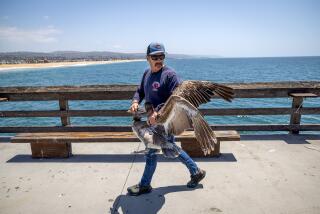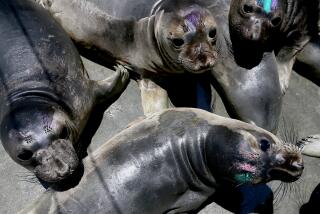300 Dead Baby Terns Litter Beach
The tale of the terns began last week with scientists crowing over the discovery of a large colony in the water off Long Beach.
The birds -- members of the Caspian and elegant subspecies of terns -- were found nesting on a barge just south of Island White.
It’s rare for the terns to nest there -- they usually make their home on Terminal Island -- so scientists and other bird watchers were excited.
But the tale turned tragic this week when lifeguards found more than 300 young terns washed up dead or dying along the shore. Now, the International Fund for Animal Welfare is offering a $10,000 reward for information leading to an arrest in what authorities suspect may be foul play.
The birds apparently fell from the barge. They could not float in the water or fly because they had not yet grown enough feathers.
“It looks as if it was human-caused,” said Karen Benzel, spokeswoman for the International Bird Rescue Research Center’s San Pedro office, where the surviving birds were taken. “Many of them were just hatched. There’s no way for them to jump in the water.”
Lifeguards found the chicks Wednesday morning scattered along the surf line and called the wildlife research center. When rescuers and veterinarians arrived, they found 270 elegant and 35 Caspian birds along the water’s edge.
Sixteen surviving chicks were scooped up and rushed to the center, volunteer veterinarian Heather Nevill said. One was euthanized because of a broken wing.
Surviving chicks with low blood pressure, shock and hypothermia were put in incubators, Nevill said. Those in good health were placed in a protective outdoor pen, where they will grow the rest of their feathers before being released.
Necropsies are being performed on some of the birds to confirm the cause of death, center employee Erin Kellogg said, but it is unlikely that they died from disease or illness because they were well-nourished.
Heat or wind could have disturbed the colony, Kellogg said, but “probably not.”
“There are still so many on the barge now that it leads us to believe it is not a natural occurrence,” she said.
Boats getting too close to the barge are another possible disturbance.
Kent Smirl, a patrol lieutenant with the state Department of Fish and Game, which along with the Coast Guard helped collect the birds, said hundreds of terns still remain on the barge, but authorities have not approached closer than 100 feet.
Even from a distance, Smirl said, protective parents “dive-bomb” their boats to defend the chicks.
“It’s like walking into a nursery,” he said.
Smirl said he was not sure if the barge, typically a vessel for transporting rocks, was abandoned, but authorities are trying to contact the owner.
No signs were posted on the boat to notify people about the colony, he said.
About 2,000 elegant and Caspian terns nest in a breeding colony near Terminal Island, making the area a tourist attraction. The delicate white-and-black birds are protected under the federal Migratory Bird Treaty Act, Smirl said, and it is a misdemeanor to disturb them. Animal cruelty is a felony in California.
Nevill said the tragedy underscores why people should avoid large colonies, particularly those with newly hatched chicks.
“A good rule of thumb: If you think you’re too close, you probably are,” Nevill said.
Anyone with information about what might have disturbed the birds is asked to call Smirl at (714) 638-8488.
More to Read
Sign up for Essential California
The most important California stories and recommendations in your inbox every morning.
You may occasionally receive promotional content from the Los Angeles Times.










